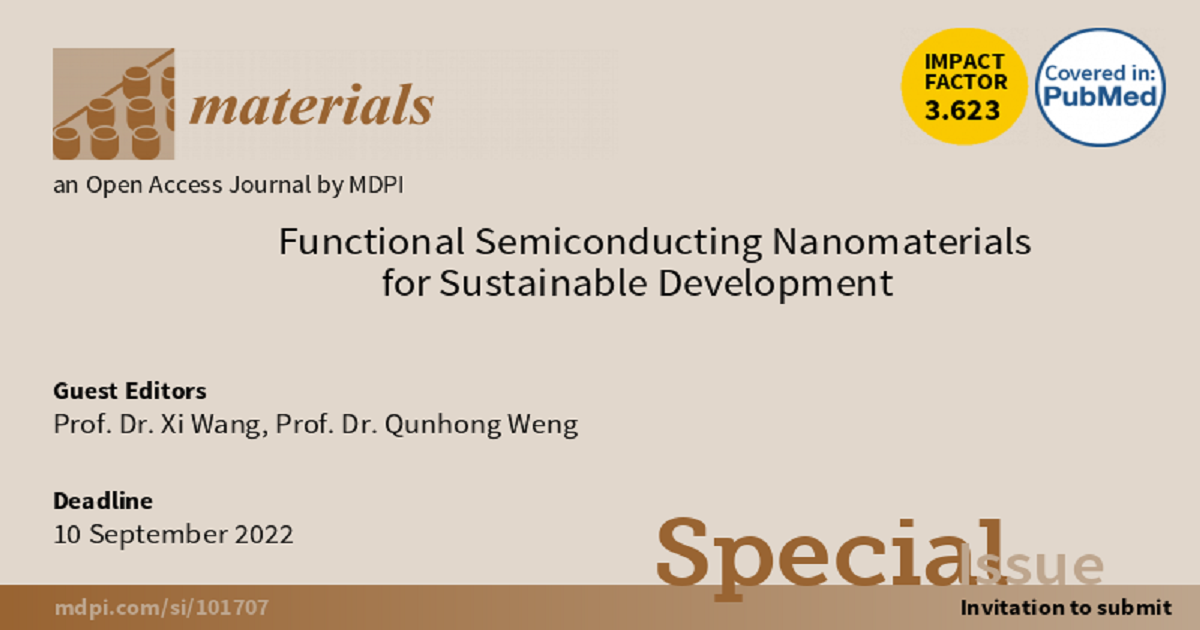- 3.2Impact Factor
- 6.4CiteScore
- 16 daysTime to First Decision
Functional Semiconducting Nanomaterials for Sustainable Development
This special issue belongs to the section “Energy Materials“.
Special Issue Information
Dear Colleagues,
Our society faces many challenges in the fields of energy, environment, health, etc. How to realize sustainable development is very important for tackling these issues. Nowadays, innovation and development in advanced materials, especially functional semiconducting nanomaterials, have played an important role in addressing these problems and achieving a sustainable society. First of all, for clean, renewable energy harvest, storage, and utilization, semiconducting nanomaterials have exhibited substantial importance. Many cutting-edge photocatalysts have been found that can effectively produce hydrogen and other fuels under solar irradiation, including g-C3N4, ZnO, TiO2, WO3, etc. Compound semiconductor nanomaterials, such as metal dichalcogenides, phosphides, and oxides, can be used for efficient electrochemical/photophysical energy storage and conversion. In terms of environmental protection, semiconductor nanomaterials can be used to capture and catalytically decompose pollutants in air and water. Moreover, the quick development of nanomedicine has also aroused intense interest in the use of semiconductor nanomaterials with novel optical, photochemical, and photophysical properties for health-related outcomes, such as anti-tumor, anti-bacterial, bioimaging, etc. It is clear that the emerging functional semiconducting nanomaterials will provide powerful tools to study and understand nature at a new, in-depth level, and will solve the challenges we are facing in the energy, environment, and health fields, which are critical for realizing sustainable development. Potential topics include, but are not limited to, the following:
- Fabrications of semiconducting nanomaterials.
- Luminance, electrical, and chemical properties of semiconducting nanomaterials.
- Photocatalysts.
- Water splitting.
- Photothermal conversions.
- Solar cells.
- Hydrogen production, storage, and utilization.
- Pollutant removal and treatment.
- Photodynamic therapy.
- Bioimaging.
- Drug delivery.
Prof. Dr. Xi Wang
Prof. Dr. Qunhong Weng
Guest Editors
Manuscript Submission Information
Manuscripts should be submitted online at www.mdpi.com by registering and logging in to this website. Once you are registered, click here to go to the submission form. Manuscripts can be submitted until the deadline. All submissions that pass pre-check are peer-reviewed. Accepted papers will be published continuously in the journal (as soon as accepted) and will be listed together on the special issue website. Research articles, review articles as well as short communications are invited. For planned papers, a title and short abstract (about 250 words) can be sent to the Editorial Office for assessment.
Submitted manuscripts should not have been published previously, nor be under consideration for publication elsewhere (except conference proceedings papers). All manuscripts are thoroughly refereed through a single-blind peer-review process. A guide for authors and other relevant information for submission of manuscripts is available on the Instructions for Authors page. Materials is an international peer-reviewed open access semimonthly journal published by MDPI.
Please visit the Instructions for Authors page before submitting a manuscript. The Article Processing Charge (APC) for publication in this open access journal is 2600 CHF (Swiss Francs). Submitted papers should be well formatted and use good English. Authors may use MDPI's English editing service prior to publication or during author revisions.
Keywords
- nanomaterials
- optical
- catalysis
- battery
- energy
- hydrogen
- environment

Benefits of Publishing in a Special Issue
- Ease of navigation: Grouping papers by topic helps scholars navigate broad scope journals more efficiently.
- Greater discoverability: Special Issues support the reach and impact of scientific research. Articles in Special Issues are more discoverable and cited more frequently.
- Expansion of research network: Special Issues facilitate connections among authors, fostering scientific collaborations.
- External promotion: Articles in Special Issues are often promoted through the journal's social media, increasing their visibility.
- e-Book format: Special Issues with more than 10 articles can be published as dedicated e-books, ensuring wide and rapid dissemination.

